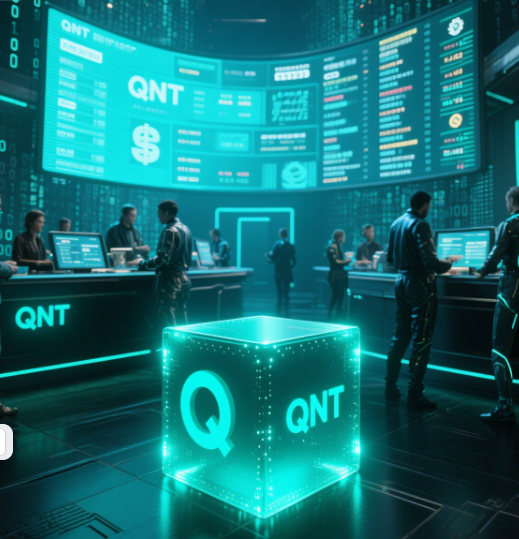This is where Quant (QNT), the native token of the Quant Network, offers a distinct and scalable solution.
The Growing Demand for Blockchain Interoperability
One of the most significant bottlenecks in the adoption of blockchain technology—especially in enterprise environments—is lack of interoperability. With thousands of blockchains emerging, businesses face growing challenges when attempting to integrate legacy systems with multiple distributed ledgers. This is where Quant (QNT), the native token of the Quant Network, offers a distinct and scalable solution.
Quant’s Overledger Network has been specifically engineered to bridge different blockchains, enabling seamless cross-chain operations without requiring additional infrastructure. This approach is different from Layer-1 or Layer-2 scaling methods; instead, it acts as an abstraction layer, making it blockchain-agnostic.
According to a 2023 Deloitte report, 94% of surveyed enterprises consider blockchain interoperability a “critical priority,” yet only 10% had implemented practical solutions. Quant is designed to fill this gap, helping enterprises develop secure, compliant, and scalable blockchain applications.
Why QNT Matters in a Tokenized Economy
As the global economy inches toward tokenization—from assets and securities to identity and data—the need for a universal communication layer becomes paramount. The QNT token powers Quant’s Overledger, serving multiple roles:
License fees: Developers must pay in QNT to use Overledger services.
Access control: Enterprises need QNT to authenticate and access the platform.
Staking and security: QNT is used to secure network operations and enforce compliance.
A recent Forrester Research analysis noted that Quant’s unique token utility model gives it a strategic edge, particularly for institutions managing multiple blockchains across jurisdictions.
Quant has already forged key partnerships in the financial sector. In 2021, the U.K. HM Treasury selected Quant to participate in the Digital Pound Foundation, underlining the government’s recognition of its technology for national-level tokenization frameworks.
Pain Points Solved by Quant’s Technology
1. Integrating Legacy Systems into DLTs
Most financial institutions run on legacy systems like SWIFT, ISO 20022, or centralized databases. Overledger’s API gateway allows developers to connect traditional systems to blockchains without overhauling backend infrastructure. This drastically reduces cost and deployment time.
2. Regulatory Compliance
Quant’s framework is built with ISO/TC 307 compliance in mind—a key advantage for global enterprises seeking to navigate the complex web of international blockchain regulations.
3. Fragmented Blockchain Ecosystem
With Overledger, users can launch multi-DLT smart contracts (MAPPs). This allows developers to interact with multiple blockchains simultaneously, from Ethereum and Bitcoin to Hyperledger and Corda, all from a single interface.

Is QNT a Good Investment?
From a tokenomics perspective, QNT has a fixed supply of 14.6 million, with no inflation mechanism. This scarcity aligns with Bitcoin’s deflationary model, potentially making QNT an attractive long-term store of value.
Data from CoinMarketCap shows that QNT has maintained a consistent price floor relative to its peers, even during bearish market conditions. Its use case as an enterprise-grade utility token grants it a degree of resilience seldom found in speculative altcoins.
Moreover, as more enterprises adopt Overledger, demand for QNT will rise proportionally, due to its licensing model. This introduces a direct economic feedback loop, uncommon in most Layer-1 projects.
The Future of QNT: Beyond Finance
Although Quant is best known for its financial applications, its architecture is highly adaptable. Use cases are emerging in healthcare data management, supply chain traceability, and digital identity systems.
For example, Quant is collaborating with LACChain, an initiative by the Inter-American Development Bank, to foster blockchain-based identity solutions in Latin America. These real-world applications demonstrate Quant’s readiness to scale beyond theory.
As the World Economic Forum projects that 10% of global GDP will be stored on blockchain by 2030, protocols like Quant will be foundational to ensure interoperability, compliance, and scalability in this future economy.
Conclusion
Quant Network, powered by the QNT token, offers more than a blockchain solution—it offers a paradigm shift in how blockchains communicate and scale in the real world. In a digital economy that demands seamless integration, regulatory certainty, and security, Quant has positioned itself not just as relevant—but as indispensable.
Stay informed on the latest crypto innovations with coin78, your trusted digital asset intelligence platform.
About the Author
Dr. Elena Navarro is a fintech strategist and decentralized systems researcher with over a decade of experience in digital assets, blockchain regulation, and enterprise integration. She holds a PhD in Information Systems from ETH Zurich and frequently consults on blockchain governance models for public and private institutions worldwide.
1. The information content does not constitute investment advice, investors should make independent decisions and bear their own risks
2. The copyright of this article belongs to the original author, and only represents the author's personal views, not the views or positions of Coin78. This article comes from news media and does not represent the views and positions of this website.
 USD
USD CNY
CNY HKD
HKD TWD
TWD VND
VND USDT
USDT